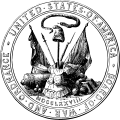Army of the Ohio
| Army of the Ohio | |
|---|---|
| Active | 1861–62 1863–65 |
| Country | John M. Schofield |
The Army of the Ohio was the name of two Union armies in the American Civil War. The first army became the Army of the Cumberland and the second army was created in 1863.
History
1st Army of the Ohio
General Orders No. 97 appointed
Buell was replaced as commander of the Department of the Ohio by Brig. Gen.
The battle Thomas foresaw occurred on October 8, 1862, west of Perryville, Kentucky. Confederate General Braxton Bragg had marched into Kentucky to recruit soldiers and take the state from the Union. The full force of Buell's command was gathering when Bragg attacked. Known as the Battle of Perryville, or the Battle of Chaplin Hills, casualties were very high on both sides.
Union casualties totaled 4,276 (894 killed, 2,911 wounded, 471 captured or missing). Confederate casualties were 3,401 (532 killed, 2,641 wounded, 228 captured or missing). [1] Although Union losses were higher, Bragg withdrew from Kentucky when the fighting was over, and therefore Perryville is considered a strategic victory for the Union.
Buell was subsequently relieved of all field command. Maj. Gen.
2nd Army of the Ohio

On 25 March 1863, Maj. Gen.
Meanwhile, the new Army of the Ohio' XXIII Corps repelled
Foster's time in command of the Army was short. On February 9, 1864, Maj. Gen.
The XXIII Corps was ordered to North Carolina and only Cox's division was present for the
Commanders
- Maj. Gen. Don Carlos Buell (November 15, 1861 – October 24, 1862) also department commander until March 11
- Maj. Gen. William S. Rosecrans (October 24–30, 1862) became the Army of the Cumberland
- Maj. Gen. Ambrose Burnside (March 25 – December 9, 1863) also department commander
- Maj. Gen. John G. Foster (December 9, 1863 – February 9, 1864) also department commander
- Maj. Gen. John M. Schofield (February 9 – September 14, 1864) also department commander
- Maj. Gen. Jacob D. Cox (September 14 – October 22, 1864)
- Maj. Gen. John M. Schofield (October 22, 1864 – February 2, 1865)
- Maj. Gen. Jacob D. Cox (February 2–9, 1865)
- Maj. Gen. John M. Schofield (February 9 – March 31, 1865) also commander of the Department of North Carolina
Major battles and campaigns
- Battle of Shiloh (Buell)
- Battle of Perryville (Buell)
- Morgan's Raid (Burnside)
- Knoxville Campaign(Burnside), (Foster)
- Atlanta Campaign(Schofield)
- Battle of Franklin(Schofield)
- Battle of Nashville (Schofield)
- Carolinas Campaign(Schofield)
Orders of Battle
- Shiloh Union order of battle
- Perryville Union order of battle
- Knoxville Union order of battle
- Atlanta Campaign Union order of battle
- Franklin Union order of battle
- Nashville Union order of battle
- Wilmington Union order of battle
Notes
1. Livermore, Thomas L., Numbers and Losses in the American Civil War 1861–1865, New York, 1901, p. 95, cited in McDonough, James Lee, War in Kentucky, University of Tennessee Press, 1994, pp 289–290.

